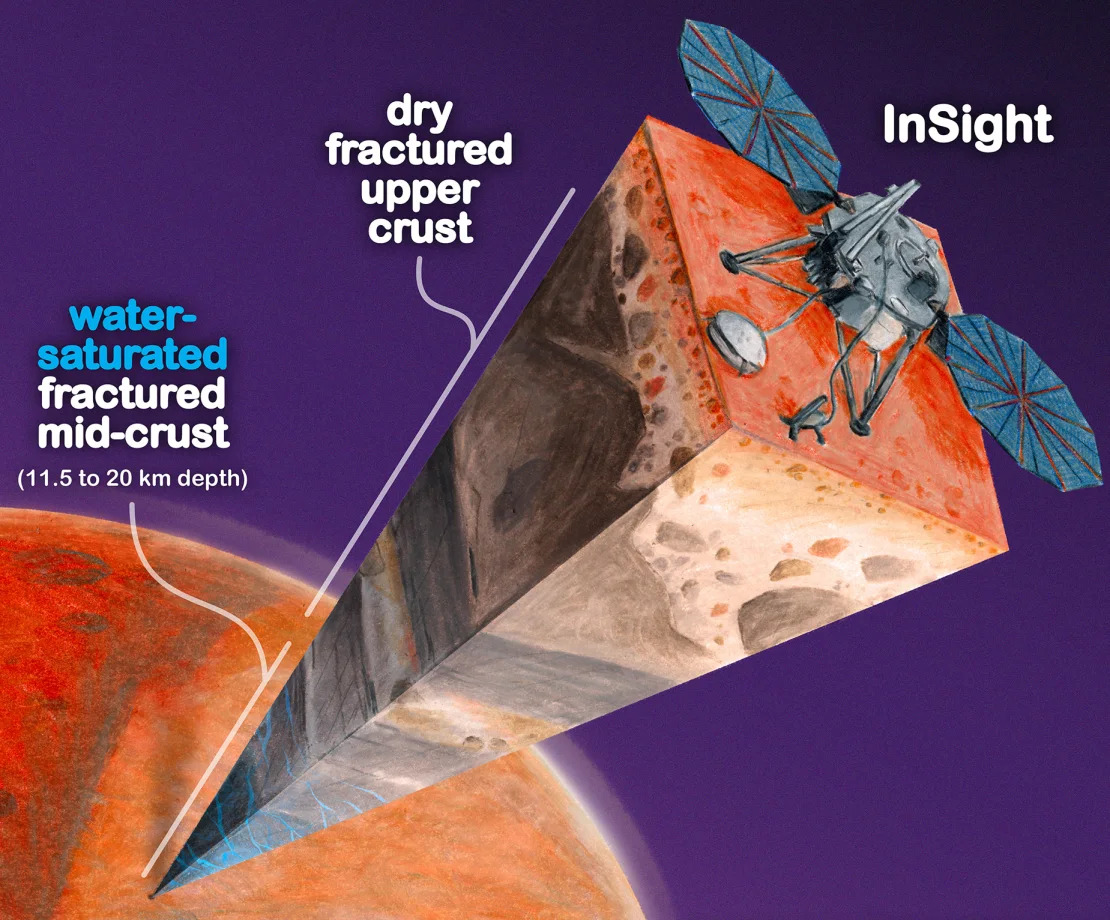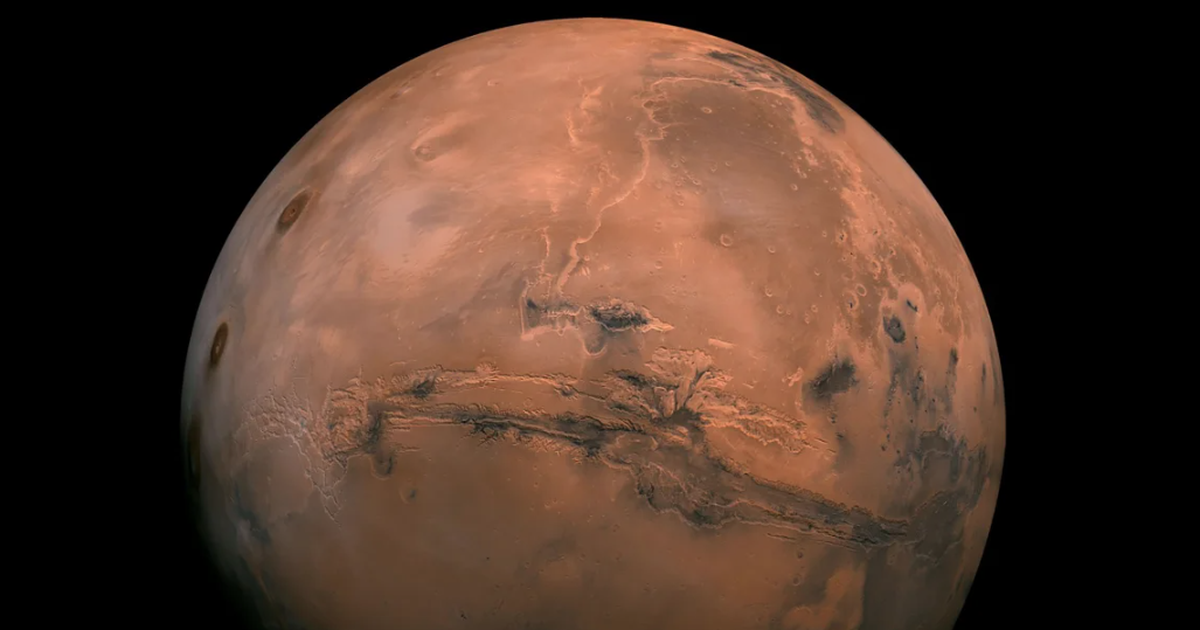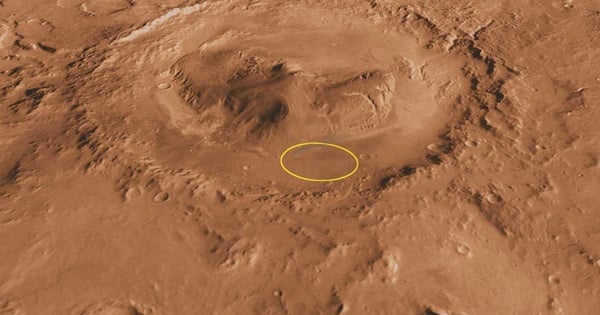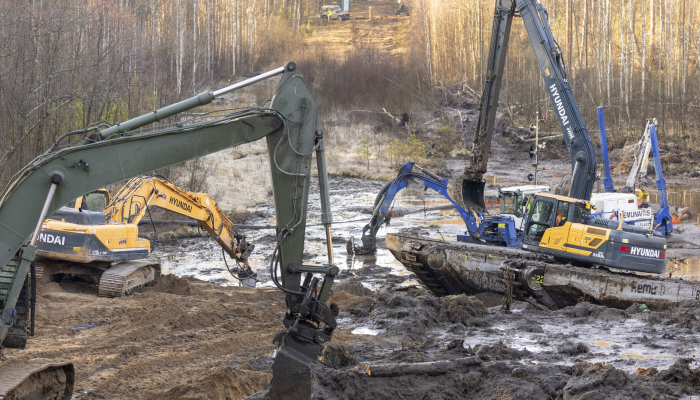Data from NASA’s InSight lander has revealed evidence of an underground water reservoir deep beneath the surface of Mars, according to a study published on August 12 in the Proceedings of the National Academy of Sciences. The spacecraft used seismometers to study the interior of Mars from 2018 to 2022.
According to a team of scientists, there may be enough water in the small cracks and voids in the Martian crust to fill the planet's oceans. The study found that groundwater could cover the entire planet to a depth of 1.6 kilometers.
However, if they try to access this water source, future astronauts exploring Mars will face many challenges because it is located at a depth of 11.5 to 20 km below the planet's surface.
The discovery reveals new details about the geological history of Mars, and suggests a new place to look for life on the red planet if water is accessible.

This illustration shows NASA's InSight mission on the surface of Mars using scientific instruments to study the interior of the red planet. Photo: NASA/JPL-Caltech
The search for 'missing' water on Mars
Evidence of lakes, river channels, deltas, and ancient rocks altered by water suggests that Mars was a warmer, wetter place billions of years ago. But the red planet lost its atmosphere more than 3 billion years ago, essentially ending the wet period on Mars.
Scientists are still unsure why Mars lost its atmosphere. Numerous missions have been developed to learn about the history of water on the planet, where it went, and whether water ever created conditions for life on Mars.
Although water is still trapped as ice in the planet's polar ice caps, researchers do not believe that can account for all of the planet's "lost" water.
New findings suggest that water on Mars has seeped into the Martian crust. The InSight lander's seismometer has detected the planet's first earthquakes, called marsquakes.
The team used this data and fed it into a mathematical model of rock physics to map oil deposits and underground aquifers. The results showed that InSight's data best matched deep igneous or volcanic rocks filled with liquid water.

Seismic data collected by InSight has helped researchers determine more information about Mars' upper and middle crust. Photo: Scripps Institution of Oceanography
Many challenges remain to exploiting Mars' water resources.
If the Martian crust is similar across the planet, there may be more water in the mid-crustal region, making it potentially habitable, much like deep groundwater on Earth is suitable for microbial life, the authors write in the study.
But even drilling holes just 1 kilometer deep on Earth is a challenge that requires energy and infrastructure, so it would be necessary to bring a large amount of resources to Mars to drill to such depths.
This is the first time data from a Mars mission has confirmed the idea that liquid water exists deep below the surface of the planet, said planetary scientist Alberto Fairén of Cornell University's astronomy department. He said the source of the water could be "some kind of deep underground mud."
Scientists have expressed interest in sending more seismometers to Mars, the Moon, and other planets in the solar system in the future. While InSight’s single seismometer will collect important data, spreading them across Mars would reveal variations within the planet and provide deeper insight into its diverse and complex history.
Hoai Phuong (according to CNN)
Source: https://www.congluan.vn/phat-hien-bang-chung-ve-ho-chua-nuoc-ngam-khong-lo-tren-sao-hoa-post307484.html



![[Photo] National Assembly Chairman Tran Thanh Man meets with King Philippe of Belgium](https://vstatic.vietnam.vn/vietnam/resource/IMAGE/2025/4/1/c6fb3ef1d4504726a738406fb7e6273f)
![[Photo] Queen of the Kingdom of Belgium and the wife of President Luong Cuong visit Uncle Ho's Stilt House](https://vstatic.vietnam.vn/vietnam/resource/IMAGE/2025/4/1/9752eee556e54ac481c172c1130520cd)
![[Photo] Official welcoming ceremony for the King and Queen of the Kingdom of Belgium](https://vstatic.vietnam.vn/vietnam/resource/IMAGE/2025/4/1/9e1e23e54fad482aa7680fa5d11a1480)
![[Photo] President Luong Cuong and the King of Belgium witness the Vietnam-Belgium document exchange ceremony](https://vstatic.vietnam.vn/vietnam/resource/IMAGE/2025/4/1/df43237b0d2d4f1997892fe485bd05a2)
![[Photo] President Luong Cuong meets with King Philippe of Belgium](https://vstatic.vietnam.vn/vietnam/resource/IMAGE/2025/4/1/1ce6351a31734a1a833f595a89648faf)



























































































Comment (0)